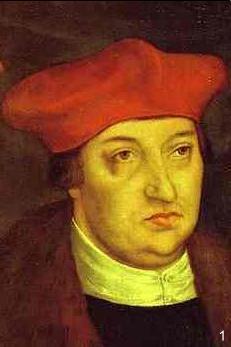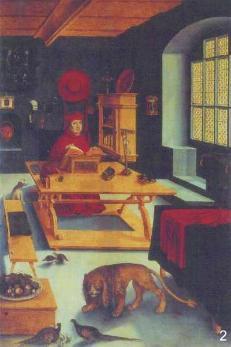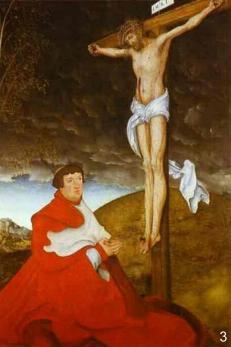
"My most Illustrious and most Excellent Lord"
|
|
Albert of BrandenburgCardinal and Elector of the Holy Roman Empire, born 28 June, 1490; died 24 September, 1545. As early as 1509 he was Prebendary in the Cathedral of Mainz; Archbishop of Magdeburg and Administrator of Halberstadt from 1513; Archbishop of Mainz from 1514; Cardinal-Priest from 1518. The Indulgence issued by Leo X in 1514 for the building of the new St. Peter's in Rome, was entrusted to Albert (1517) for publication in Saxony and Brandenburg, This commission has been made by D'Aubigné and others the ground of many accusations against Albert and Leo X, as though they had used the Indulgence as a means of enriching themselves personally, "dividing beforehand the spoils of the credulous souls of Germany" (D'Aubigné, History of the Reformation). Albert employed Tetzel for the actual preaching of the Indulgence and furnished him a book of instructions: "Instructio summaria ad Subcommissarios Poenitentiarum et Confessores." Later, Martin Luther addressed a letter of protest to Albert concerning the conduct of Tetzel, found fault with the Bishop's book of instructions, and asked him to suppress it. Luther's charges are altogether groundless; the instructions of Albert to the preachers are both wise and edifying. Luther's letter was disregarded. Though many of the accusations against Albert's morals were, doubtless, false, Luther was probably justified in thinking that he would find in Albert a strong partisan. The young bishop was somewhat worldly-minded, extravagant, better trained in humanistic studies than in theology, too much given to the patronage of learned men and artists. His long intimacy with Ulrich von Hutten is especially reprehensible. Leo X was obliged to send an admonition to Mainz because so many books hostile to the Faith were being published under the Bishop's eye. In later life Albert changed his conduct. In his diocese celebrated defenders of Catholicism were engaged; at Speyer and Ratisbon he met Blessed Peter Faber, S. J., and kept him in his diocese (1542-43); after this he was always a friend to the new order. Albert strove earnestly to introduce a ore perfect system of religious instruction and brought forward measures for that purpose in the Diet of Nuremberg. He became by the sincerity of his zeal the great defender of the Faith in Germany. As a temporal prince, he ruled his electorate well; he introduced reforms in the administration of justice, into the police system ,and into commerce. He was buried in the Cathedral of Mainz. An artistic memorial marks the resting-place of his remains. ALZOG, Universal Church History, PABISCH-BYRNE tr. (Cincinnati, 1876); ROSCOE, Life of Leo X; D'AUBIGNE, History of Reformation in Germany and Switzerland, Eng. Tr. (Philadelphia, 1843); SMITH, Luther and Tetzel (Cath. Truth Soc. Publication) 43; ROTHBACHER, Histoire universelle de l'eglise catholique, IX,; PALLAVICINO, Istoria del Concilio di Trento (Rome, 1833); ORLANDINI, Historia Soc. Jesu (Cologne, 1615). M.J. O'MALIA The Catholic Encyclopedia,
Volume I
Maybe it's not by chance the Cathedral of Mainz was and continues to be one of the most popular sites of the Mary's cult in Germany. The painting Mother of All Men was ended in 1544, a year before the Albert's death, probably ordered by a Lombard noble friend who wanted to make him a gift. Paintings of Lucas Cranach the Elder: 1) Portrait of cardinal Albrecht of Brandenburg, 1526 (detail) - Hermitage, Saint Peterburg. 2) The cardinal Albrecht of Brandenburg as Saint Jeronimus, 1525 - Hessisches Landesmuseum Darmstadt. 3) The cardinal Albrecht of Brandenburg beneath Crucified Jesus, 1520-1530 - Alte Pinacotheke, Munchen Germany.
|


